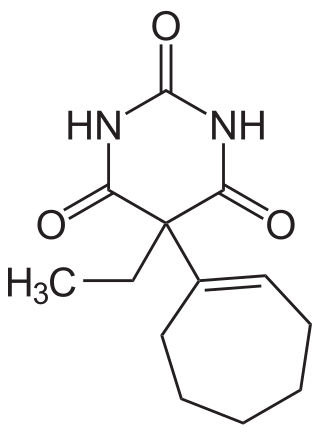
Hypnotic, or soporific drugs, commonly known as sleeping pills, are a class of psychoactive drugs whose primary function is to induce sleep and to treat insomnia (sleeplessness).

Sodium thiopental, also known as Sodium Pentothal, thiopental, thiopentone, or Trapanal, is a rapid-onset short-acting barbiturate general anesthetic. It is the thiobarbiturate analog of pentobarbital, and an analog of thiobarbital. Sodium thiopental was a core medicine in the World Health Organization's List of Essential Medicines, but was supplanted by propofol. Despite this, thiopental is listed as an acceptable alternative to propofol, depending on local availability and cost of these agents. It was previously the first of three drugs administered during most lethal injections in the United States, but the US manufacturer Hospira stopped manufacturing the drug in 2011 and the European Union banned the export of the drug for this purpose. Although thiopental abuse carries a dependency risk, its recreational use is rare.
A depressant, or central depressant, is a drug that lowers neurotransmission levels, which is to depress or reduce arousal or stimulation, in various areas of the brain. Depressants are also colloquially referred to as downers as they lower the level of arousal when taken. Stimulants or "uppers" increase mental or physical function, hence the opposite drug class of depressants is stimulants, not antidepressants.

Flurazepam is a drug which is a benzodiazepine derivative. It possesses anxiolytic, anticonvulsant, hypnotic, sedative and skeletal muscle relaxant properties. It produces a metabolite with a long half-life, which may stay in the bloodstream for days. Flurazepam was patented in 1968 and came into medical use the same year. Flurazepam, developed by Roche Pharmaceuticals was one of the first benzo hypnotics to be marketed.

Meprobamate—marketed as Miltown by Wallace Laboratories and Equanil by Wyeth, among others—is a carbamate derivative used as an anxiolytic drug. It was the best-selling minor tranquilizer for a time, but has largely been replaced by the benzodiazepines due to their wider therapeutic index and lower incidence of serious side effects.

Butabarbital is a prescription barbiturate sleep aid and anxiety medication. Butabarbital has a particularly fast onset of effects and short duration of action compared to other barbiturates, which makes it useful for certain applications such as treating severe insomnia, relieving general anxiety and relieving anxiety before surgical procedures; however it is also relatively dangerous particularly when combined with alcohol, and so is now rarely used, although it is still prescribed in some Eastern European and South American countries. Its intermediate duration of action gives butabarbital an abuse potential slightly lower than secobarbital. Butabarbital can be hydrolyzed to Valnoctamide.

Heptabarb, also known as heptabarbitone (BAN) or heptabarbital, is a sedative and hypnotic drug of the barbiturate family. It was used in Europe for the treatment of insomnia from the 1950s onwards, but has since been discontinued.

Hexobarbital or hexobarbitone, sold both in acid and sodium salt forms as Citopan, Evipan, and Tobinal, is a barbiturate derivative having hypnotic and sedative effects. It was used in the 1940s and 1950s as an agent for inducing anesthesia for surgery, as well as a rapid-acting, short-lasting hypnotic for general use, and has a relatively fast onset of effects and short duration of action. It was also used to murder women prisoners at Ravensbrück concentration camp. Modern barbiturates have largely supplanted the use of hexobarbital as an anesthetic, as they allow for better control of the depth of anesthesia. Hexobarbital is still used in some scientific research.

Alphenal, also known as 5-allyl-5-phenylbarbituric acid, is a barbiturate derivative developed in the 1920s. It has primarily anticonvulsant properties, and was used occasionally for the treatment of epilepsy or convulsions, although not as commonly as better known barbiturates such as phenobarbital.

Delorazepam, also known as chlordesmethyldiazepam and nordiclazepam, is a drug which is a benzodiazepine and a derivative of desmethyldiazepam. It is marketed in Italy, where it is available under the trade name EN and Dadumir. Delorazepam (chlordesmethyldiazepam) is also an active metabolite of the benzodiazepine drugs diclazepam and cloxazolam. Adverse effects may include hangover type effects, drowsiness, behavioural impairments and short-term memory impairments. Similar to other benzodiazepines delorazepam has anxiolytic, skeletal muscle relaxant, hypnotic and anticonvulsant properties.

Y-23684 is an anxiolytic drug with a novel chemical structure, which is used in scientific research. It has similar effects to benzodiazepine drugs, but is structurally distinct and so is classed as a nonbenzodiazepine anxiolytic.

Benzylbutylbarbiturate is a rare example of a barbiturate designer drug, possibly the only such compound encountered in recent years.

Barbiturates are a class of depressant drugs that are chemically derived from barbituric acid. They are effective when used medically as anxiolytics, hypnotics, and anticonvulsants, but have physical and psychological addiction potential as well as overdose potential among other possible adverse effects. They have been used recreationally for their anxiolytic and sedative effects, and are thus controlled in most countries due to the risks associated with such use.
Barbiturate dependence develops with regular use of barbiturates. This in turn may lead to a need for increasing doses of the drug to get the original desired pharmacological or therapeutic effect. Barbiturate use can lead to both addiction and physical dependence, and as such they have a high potential for excess or non-medical use, however, it does not affect all users. Management of barbiturate dependence involves considering the affected person's age, comorbidity and the pharmacological pathways of barbiturates.

Heptobarbital (Rutonal), also known as phenylmethylbarbituric acid is a barbiturate derivative. It has often been confused with methylphenobarbital because both drugs contain a methylphenyl moiety and are overall very similar in structure.

Thiotetrabarbital is a drug which is a short-acting barbiturate derivative that is used as an anesthetic. It has been used in veterinary medicine.

Methitural, or methitural sodium, also known as methioturiate, is a barbiturate derivative which was marketed in the 1950s in Europe as an ultra-short-acting intravenous anesthetic.

Propylbarbital, also known as 5,5-dipropylbarbituric acid, is a barbiturate derivative used as a hypnotic drug.

Buthalital sodium, or buthalitone sodium (BAN), is a barbiturate derivative which was under development as a short-acting anesthetic. However, development was discontinued, perhaps due to its extremely rapid elimination rate, and buthalital sodium was never marketed.

In pharmacology, GABAA receptor positive allosteric modulators are positive allosteric modulator (PAM) molecules that increase the activity of the GABAA receptor protein in the vertebrate central nervous system.


















